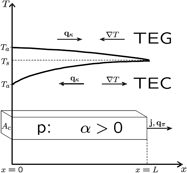Crossref Citations
This article has been cited by the following publications. This list is generated based on data provided by Crossref.
Goupil, Christophe
Seifert, Wolfgang
Zabrocki, Knud
Müller, Eckhart
and
Snyder, G. Jeffrey
2011.
Thermodynamics of Thermoelectric Phenomena and Applications.
Entropy,
Vol. 13,
Issue. 8,
p.
1481.
Gerstenmaier, York Christian
and
Wachutka, Gerhard
2012.
Unified theory for inhomogeneous thermoelectric generators and coolers including multistage devices.
Physical Review E,
Vol. 86,
Issue. 5,
Seifert, Wolfgang
and
Pluschke, Volker
2012.
Exact Solution of a Constraint Optimization Problem for the Thermoelectric Figure of Merit.
Materials,
Vol. 5,
Issue. 12,
p.
528.
Snyder, G. Jeffrey
Toberer, Eric S.
Khanna, Raghav
and
Seifert, Wolfgang
2012.
Improved thermoelectric cooling based on the Thomson effect.
Physical Review B,
Vol. 86,
Issue. 4,
Seifert, Wolfgang
Snyder, G. Jeffrey
Toberer, Eric S.
Goupil, Christophe
Zabrocki, Knud
and
Müller, Eckhard
2013.
The self-compatibility effect in graded thermoelectric cooler elements.
physica status solidi (a),
Vol. 210,
Issue. 7,
p.
1407.
Ngan, Pham Hoang
Christensen, Dennis Valbjørn
Snyder, Gerald Jeffrey
Hung, Le Thanh
Linderoth, Søren
Nong, Ngo Van
and
Pryds, Nini
2014.
Towards high efficiency segmented thermoelectric unicouples.
physica status solidi (a),
Vol. 211,
Issue. 1,
p.
9.
Seifert, Wolfgang
and
Pluschke, Volker
2014.
The extended concept of a self‐compatible thermoelectric cooler.
physica status solidi (a),
Vol. 211,
Issue. 4,
p.
917.
Xu, Shaohui
Chen, Qiang
Zhu, Yiping
Wang, Lianwei
Zheng, Lirong
and
Chu, Paul K.
2014.
Modeling and Optimization of Thermoelements by a Combined Analytical and Numerical Method.
Journal of Electronic Materials,
Vol. 43,
Issue. 2,
p.
404.
Seifert, W
Pluschke, V
and
Hinsche, N F
2014.
Thermoelectric cooler concepts and the limit for maximum cooling.
Journal of Physics: Condensed Matter,
Vol. 26,
Issue. 25,
p.
255803.
Hung, Le Thanh
Van Nong, Ngo
Linderoth, Søren
and
Pryds, Nini
2015.
Segmentation of low‐cost high efficiency oxide‐based thermoelectric materials.
physica status solidi (a),
Vol. 212,
Issue. 4,
p.
767.
Zabrocki, Knud
Goupil, Christophe
Ouerdane, Henni
Apertet, Yann
Seifert, Wolfgang
and
Müller, Eckhard
2016.
Continuum Theory andModeling of Thermoelectric Elements.
p.
75.
Seifert, Wolfgang
Snyder, G. Jeffrey
Toberer, Eric S.
Pluschke, Volker
Müller, Eckhard
and
Goupil, Christophe
2016.
Continuum Theory andModeling of Thermoelectric Elements.
p.
227.
Gaurav, Kumar
and
Pandey, Sudhir K.
2017.
Efficiency calculation of a thermoelectric generator for investigating the applicability of various thermoelectric materials.
Journal of Renewable and Sustainable Energy,
Vol. 9,
Issue. 1,
Marchenko, Oleg V.
2018.
Performance modeling of thermoelectric devices by perturbation method.
International Journal of Thermal Sciences,
Vol. 129,
Issue. ,
p.
334.
Chimal-Eguia, Juan Carlos
Páez-Hernández, Ricardo Teodoro
Pacheco-Paez, Juan Carlos
and
Ladino-Luna, Delfino
2023.
Linear Irreversible Thermodynamics: A Glance at Thermoelectricity and the Biological Scaling Laws.
Entropy,
Vol. 25,
Issue. 12,
p.
1575.





